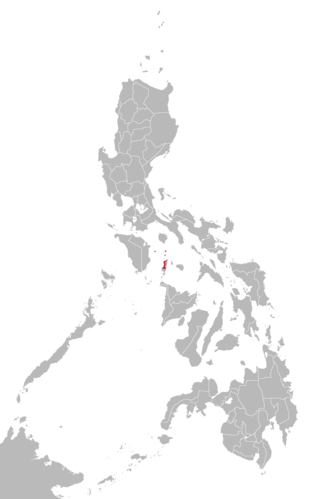
Romblon, officially the Province of Romblon, is an archipelagic province of the Philippines located in the Mimaropa region. Its main components include Romblon, an archipelagic municipality of the same name that also serves as the provincial capital; Tablas, the largest island, covering nine municipalities ; Sibuyan with its three towns; as well as the smaller island municipalities of Corcuera, Banton, Concepcion, and San Jose. The province lies south of Marinduque and Quezon, east of Oriental Mindoro, north of Aklan and Capiz, and west of Masbate. According to the 2020 census, it has a total population of 308,985.
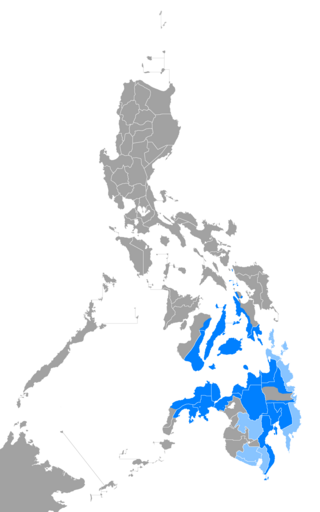
Cebuano is an Austronesian language spoken in the southern Philippines by Cebuano people and other Ethnic groups as secondary language. It is natively, though informally, called by its generic term Bisayâ or Binisayâ and sometimes referred to in English sources as Cebuan. It is spoken by the Visayan ethnolinguistic groups native to the islands of Cebu, Bohol, Siquijor, the eastern half of Negros, the western half of Leyte, and the northern coastal areas of Northern Mindanao and the eastern part of Zamboanga del Norte due to Spanish settlements during the 18th century. In modern times, it has also spread to the Davao Region, Cotabato, Camiguin, parts of the Dinagat Islands, and the lowland regions of Caraga, often displacing native languages in those areas.

The Bisayan languages or Visayan languages are a subgroup of the Austronesian languages spoken in the Philippines. They are most closely related to Tagalog and the Bikol languages, all of which are part of the Central Philippine languages. Most Bisayan languages are spoken in the whole Visayas section of the country, but they are also spoken in the southern part of the Bicol Region, islands south of Luzon, such as those that make up Romblon, most of the areas of Mindanao and the province of Sulu located southwest of Mindanao. Some residents of Metro Manila also speak one of the Bisayan languages.

Tausūg is an Austronesian language spoken in the province of Sulu in the Philippines and in the eastern area of the state of Sabah, Malaysia as well as in the Nunukan Regency, province of North Kalimantan, Indonesia by the Tausūg people. It is widely spoken in the Sulu Archipelago, the Zamboanga Peninsula, southern Palawan, Malaysia and Indonesia.
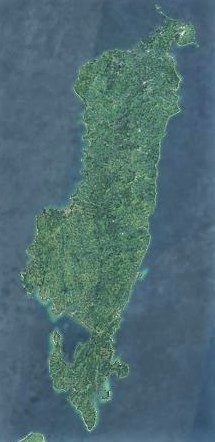
Tablas is the largest of the islands that comprise the province of Romblon in the Philippines. The name of the island is of Spanish origin. Before the colonization of the Philippines, Tablas was known as the Island of Osigan. At the time of contact with Westerners, Osigan had a population of 256 people living in small villages. Wax was produced in this island.
The Central Philippine languages are the most geographically widespread demonstrated group of languages in the Philippines, being spoken in southern Luzon, Visayas, Mindanao, and Sulu. They are also the most populous, including Tagalog, Bikol, and the major Visayan languages Cebuano, Hiligaynon, Waray, Kinaray-a, and Tausug, with some forty languages all together.

Surigaonon is an Austronesian language spoken by Surigaonon people. As a regional Philippine language, it is spoken in the province of Surigao del Norte, Dinagat Islands, Surigao del Sur, and some portions of Agusan del Norte, especially the towns near Lake Mainit, Agusan del Sur and Davao Oriental. The language, along with Butuanon and Tausug, are the only Visayan languages geographically native to Mindanao.

Masbateño or Minasbate is a member of Central Philippine languages and of the Bisayan subgroup of the Austronesian language family spoken by more than 724,000 people in the province of Masbate and some parts of Sorsogon in the Philippines. Masbatenyo is the name used by the speakers of the language and for themselves, although the term Minásbate is sometimes also used to distinguish the language from the people. It has 350,000 speakers as of 2002, with 50,000 who speak it as their first language. About 250,000 speakers use it as their second language.
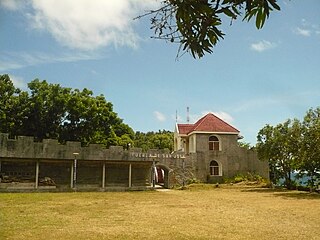
Banton, officially the Municipality of Banton, is a municipality in the province of Romblon, Philippines. According to the 2020 census, it has a population of 5,737 people.

Concepcion, officially the Municipality of Concepcion, is a municipality in the province of Romblon, Philippines. The municipality is coextensive with Maestre de Campo Island, which is also known as Sibale Island. According to the 2020 census, it has a population of 3,561 people, making it the least populated town in the province.

Corcuera, officially the Municipality of Corcuera, is a municipality in the province of Romblon, Philippines. According to the 2020 census, it has a population of 10,112 people.

Calatrava, officially the Municipality of Calatrava, is a municipality in the province of Romblon, Philippines. According to the 2020 census, it has a population of 11,342 people.
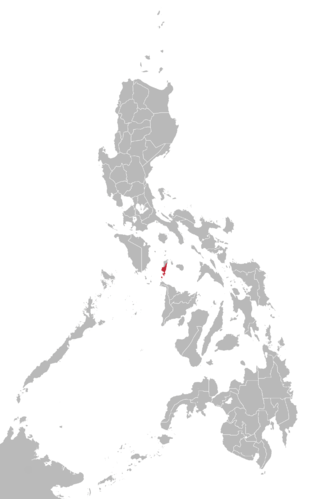
Onhan is a regional Western Bisayan language spoken, along with the Romblomanon and Asi languages, in the province of Romblon, Philippines. The language is also known as Inunhan and Loocnon.
The Iraya language is a language spoken by Mangyans on the island of Mindoro in the Philippines. Zorc (1974) places the Iraya language within the North Mangyan group of Malayo-Polynesian languages, though Lobel (2013) notes that it shows "considerable differences" to Tadyawan and Alangan, the other languages in this group. There are 6,000 to 8,000 Iraya speakers, and that number is growing. The language status of Iraya is developing, meaning that this language is being put to use in a strong and healthy manner by its speakers, and it also has its own writing system.

The Sama–Bajaw languages are a well-established group of languages spoken by the Sama-Bajau peoples of the Philippines, Indonesia, and Malaysia.
Ati (Inati), or Binisaya nga Inati, is an Austronesian language of the island of Panay in the Philippines. The variety spoken in northern Panay is also called Sogodnin. The Ati people also speak Kinaray-a and Hiligaynon.
The Bantayanon language is the regional language of the Bantayan islands in the Philippines. It is a part of the Bisayan language family and is closely related to Waray and Hiligaynon. There are three dialects of Bantayanon, based in the three municipalities that comprise the island group: Binantayanun, Linawisanun, and Sinantapihanun, the most idiosyncratic of the three. There are also significant dialectal differences between the speech patterns of those that live in the town centers and those that live outside of the more rural areas of the islands.
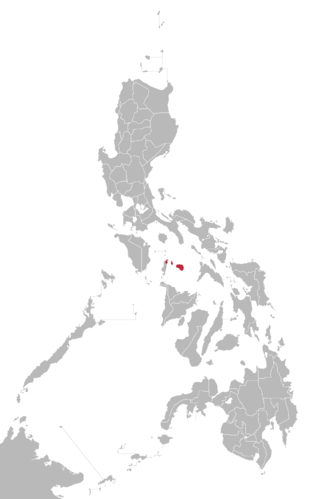
Romblomanon or Bisaya/Binisaya nga Romblomanon is an Austronesian regional language spoken, along with Asi and Onhan, in the province of Romblon in the Philippines. The language is also called Ini, Tiyad Ini, Basi, Niromblon, and Sibuyanon. It is a part of the Bisayan language family and is closely related to other Philippine languages.
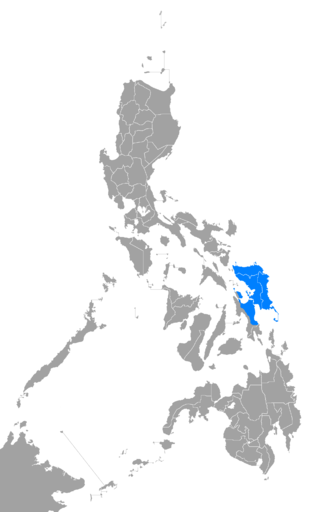
Waray is an Austronesian language and the fifth-most-spoken native regional language of the Philippines, native to Eastern Visayas. It is the native language of the Waray people and second language of the Abaknon people of Capul, Northern Samar, and some Cebuano-speaking peoples of western and southern parts of Leyte island. It is the third most spoken language among the Bisayan languages, only behind Cebuano and Hiligaynon.
Southern Sorsogon is a Bisayan language spoken in the southern part of Sorsogon, Philippines, in the municipalities of Gubat, Barcelona, Bulusan, Santa Magdalena, Matnog, Bulan, and Irosin. Although located in the Bicol Region, Southern Sorsogon belongs to the Warayan Bisayan subgroup, and is mutually intelligible to Waray which is spoken to the south on the neighboring island of Samar. The other two Bisayan languages spoken in the Bicol Region are Masbate Sorsogon and Masbateño.
